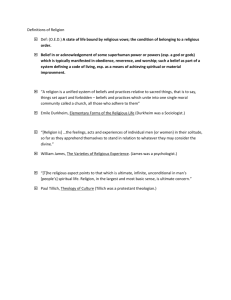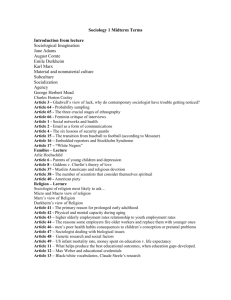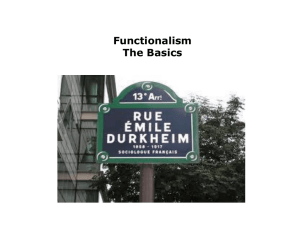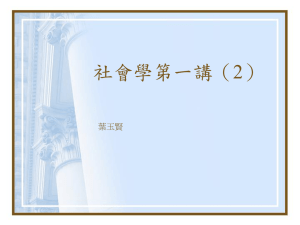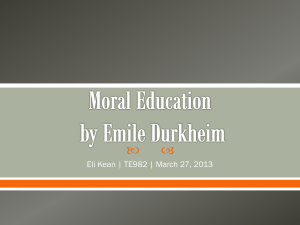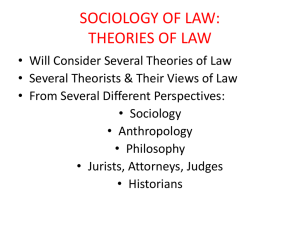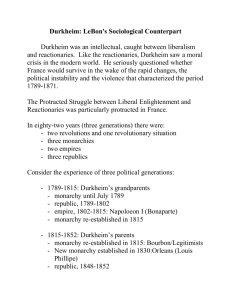SOCIOLOGY 15
advertisement
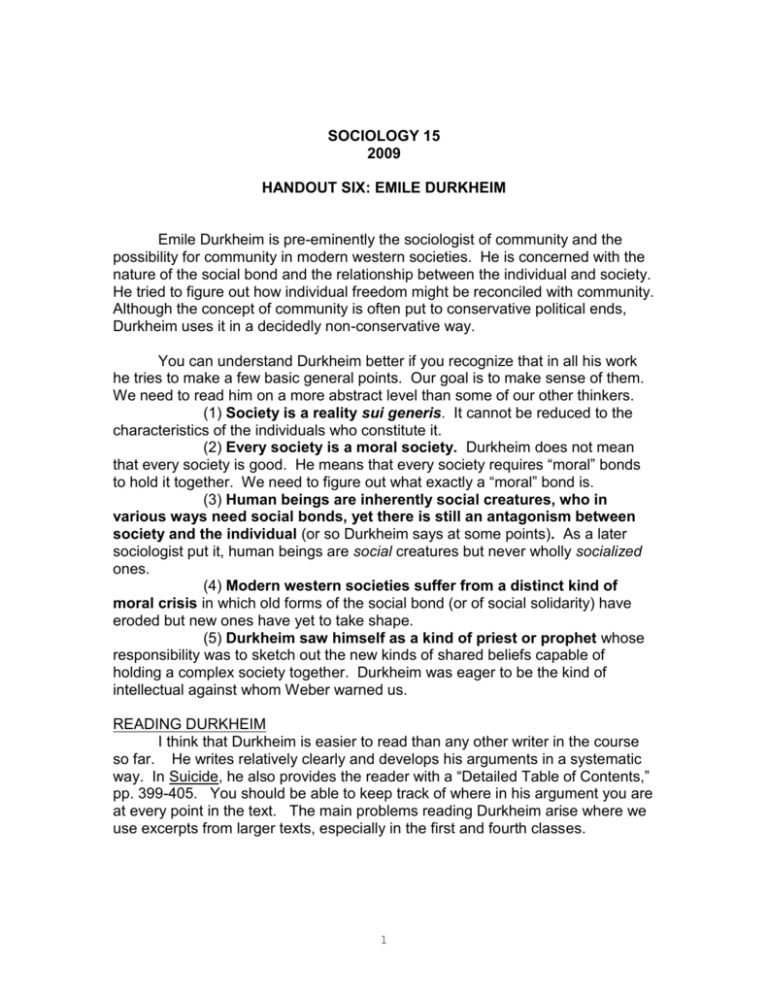
SOCIOLOGY 15 2009 HANDOUT SIX: EMILE DURKHEIM Emile Durkheim is pre-eminently the sociologist of community and the possibility for community in modern western societies. He is concerned with the nature of the social bond and the relationship between the individual and society. He tried to figure out how individual freedom might be reconciled with community. Although the concept of community is often put to conservative political ends, Durkheim uses it in a decidedly non-conservative way. You can understand Durkheim better if you recognize that in all his work he tries to make a few basic general points. Our goal is to make sense of them. We need to read him on a more abstract level than some of our other thinkers. (1) Society is a reality sui generis. It cannot be reduced to the characteristics of the individuals who constitute it. (2) Every society is a moral society. Durkheim does not mean that every society is good. He means that every society requires “moral” bonds to hold it together. We need to figure out what exactly a “moral” bond is. (3) Human beings are inherently social creatures, who in various ways need social bonds, yet there is still an antagonism between society and the individual (or so Durkheim says at some points). As a later sociologist put it, human beings are social creatures but never wholly socialized ones. (4) Modern western societies suffer from a distinct kind of moral crisis in which old forms of the social bond (or of social solidarity) have eroded but new ones have yet to take shape. (5) Durkheim saw himself as a kind of priest or prophet whose responsibility was to sketch out the new kinds of shared beliefs capable of holding a complex society together. Durkheim was eager to be the kind of intellectual against whom Weber warned us. READING DURKHEIM I think that Durkheim is easier to read than any other writer in the course so far. He writes relatively clearly and develops his arguments in a systematic way. In Suicide, he also provides the reader with a “Detailed Table of Contents,” pp. 399-405. You should be able to keep track of where in his argument you are at every point in the text. The main problems reading Durkheim arise where we use excerpts from larger texts, especially in the first and fourth classes. 1 THE INDIVIDUAL, THE DIVISION OF LABOR, AND SOCIETY On Morality and Society, Ch. 3, 4 The two essays reprinted here together lay out a number of Durkheim’s basic ideas. They are also worth comparing to each other for the apparent way in which they contradict each other. “The Principles of 1789 and Sociology” uses a review of a book on the French Revolution as an opportunity to criticize the idea that society consists merely of self-interested, egoistic individuals whose relationships with each other are merely contractual. He also criticizes the idea that society is “something against nature.”(P. 39) So, what is wrong with characterizing a person as “essentially whole, an individual and egoistic being” and regarding society as something that simply constrains or imposes itself on such individuals? “Individualism and the Intellectuals” is Durkheim’s contribution to the Dreyfus Affair, which was the pivotal political event in France in the 1890s. What he says about the guilt or innocence of Captain Dreyfus, a French military officer of Jewish background accused of treason, is less important than what he says about the relationship between individual and society. Clearly this essay is a defense of individualism. How does Durkheim defend individualism in this essay? How can this defense be reconciled with his critique of individualism in the previous essay? How does he turn the idea of individualism into a sacred belief and hence into a basis for social solidarity? On Morality and Society, Ch. 6, 7(pp. 86-92, 110-113), 8(pp. 128-133), 9. These chapters are brief selections from Durkheim's first major work, The Division of Labor in Society. In this book, Durkheim argues that the development of the division of labor is the formative trend in modern society. As roles in society become more specialized, human beings become increasingly differentiated from each other. Simpler societies, in which people do roughly similar things, are held together by very strong collective beliefs which take on a sacred aura. Durkheim called this kind of social bond “mechanical solidarity.” As the division of labor increases the collective consciousness weakens and becomes more abstract. However, these more complex societies are not simply collections of self-interested individuals held together by merely contractual bonds. By making every person dependent on every other, the division of labor creates (or at least should create) a new kind of social bond, “organic solidarity.” (You might want to think back to Tocqueville’s distinction between the two kinds of patriotism.) This argument is very important for Durkheim for at least two reasons: (1) It affirms, as he says, that “every society is a moral society.” (112) (2) While mechanical solidarity is built on a denial of individual differences, organic solidarity presupposes and affirms these differences. So, what does the claim that “every society is a moral society” mean? What does it tell us about what does or does not hold society 2 together? In what important ways do mechanical or organic solidarity develop? SUICIDE (two classes) Suicide is another of Durkheim's most important works. As with all his work, it addresses basic issues about the individual and society that go well beyond the ostensible topic. Generally, Durkheim tries to do two things in Suicide. First, establish the viability of sociology as an autonomous science (or area of inquiry) by showing that social facts are not reducible to individual (psychological) facts. Second, examine (again) the relationship between the individual and society. In what sense is society not reducible to the individuals who make it up? Why does Durkheim use suicide, which appears as the ultimate rejection of society, to make his points? The preface and the introduction define suicide and argue that the suicide rate is a phenomenon with its own properties ("sui generis," as Durkheim puts it). How does Durkheim support this claim? Book II identifies several kinds of suicide, of which we will examine two, “egoistic and “anomic.” Keep the following questions in mind: What specific variations in the suicide rate exemplify each kind of suicide? What specific features of social life cause each kind of suicide? What does each kind of suicide tell us about human nature and the relationship between the individual and society, according to Durkheim? More important: Durkheim says that both egoistic and anomic suicide result from "the disease of the infinite" (p. 287) or "the morbid desire for the infinite" (p. 271). What is this disease/desire? How do the two kinds of suicide reflect it? How can society overcome it? Understand all this and you understand Durkheim (and perhaps yourselves as well). RELIGION On Morality and Society, Ch. 10-12 Chapters 11 and 12 are selections from Durkheim’s last great work, The Elementary Forms of the Religious Life. Chapter 10 is a kind of summary of that work. Durkheim is concerned first of all with capturing what is essential to religion. Why does he study the “elementary forms” of religion to accomplish this? What are the essential features of religion and what features are secondary? What, if anything, does God have to do with religion? Durkheim is also concerned with why all societies have religious beliefs. He argues that although not literally true, religious beliefs reflect 3 something important about the social bonds between human beings. What is the social meaning of religion? Finally, Durkheim argues that human beings are dual creatures. They have a social part that is inevitably at war with their individual part. How does Durkheim justify this characterization of human beings? Of what does each part consist? We need to look closely at the individual, apparently asocial part of the human being. It is a quite slippery thing in Durkheim’s theory. 4 ADDENDUM #1: THE DIVORCE PARADOX AND DURKHEIM’S WOMAN PROBLEM Divorce, Gender, Marriage and Suicide Rate (See Suicide, p. 264 ff.) Availability of Divorce Rare Male Married men have Frequent Unmarried men have Lower suicide rate Lower suicide rate Gender Female Unmarried women have Married women Lower suicide rate Lower suicide rate have Durkheim on Women “Further we have seen that in all countries of the world women commit suicide much less than men. They are also much less educated. Fundamentally traditionalist by nature, they govern their conduct by fixed beliefs and have no great intellectual needs.” (Suicide, 166) [Emphasis added] “When a widow is seen to endure her condition much better than a widower and desires marriage less passionately, one is led to consider this ease in dispensing with the family a mark of superiority; it is said that woman’s affective faculties, being very intense, are easily employed outside the domestic circle, while her devotion is indispensable to man to help him endure life. Actually, if this is here privilege it is because her sensibility is rudimentary rather than highly developed. As she lives outside of community existence more than man, she is less penetrated by it; society is less necessary to her because she is less impregnated with sociability. She has few needs in this direction and satisfies them very easily. (215) [Emphasis added] “Woman’s sexual needs have less of a mental character because, generally speaking, her mental life is less developed....Being a more instinctive creature than man, woman has only to follow her instincts to find calmness and peace.” (272) [Emphasis added] 5 ADDENDUM #2: DOES DURKHEIM’S THEORY OF SUICIDE HOLD UP? Subsequent research tends to bear out much of Durkheim’s argument about social integration. In particular, religious and family integration are negatively related to suicide rates. In addition, one dominant theory in the study of religion, the “moral communities” thesis, argues that being religious in itself has little impact. What matters is integration into a religious community. This bears out Durkheim’s linkage between religion and “society.” One recent study looks at the impact of both community and individual level variables on suicidality. While not all the measures of social integration correlate with suicidality, family attachment does reduce suicidality, as does living in a neighborhood with a lot of adherents to conservative religious denominations. For more see: David Maimon and Danielle C. Kuhn, “Social Control and Youth Suicidality: Situating Durkheim’s Ideas in a Multilevel Framework,” ASR 73 (6): 921-943, April 2009 6

